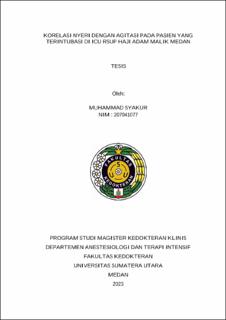| dc.description.abstract | Background: Agitation often occurs in ICU patients and can be caused by factors such as a new environment, drug exposure, medical conditions, and mental health conditions. Pain is also frequently experienced by intubated patients in the ICU undergoing medical procedures such as suctioning of the endotracheal tube, insertion of urinary catheters, nasogastric tubes, routine daily patient care, and can exacerbate agitation. In ICU care, it is important to consider the relationship between agitation, pain, delirium, and other factors to effectively manage and address the patient's condition.
Objective: To analyze the correlation between pain using CPOT (Critical-Care Pain Observation Tool) and agitation using RASS in intubated patients in the ICU of RSUP HAM.
Methods: The research design used was observational analytics with a cross-sectional design using CPOT and RASS scales as measurement tools during the period of October 2023.
Results: No differences or relationships (p>0.05) were found in all characteristic data (age, gender, BMI, length of ICU stay, and duration of ventilator use) between the non-surgical and surgical groups. There was a statistically significant difference (p<0.001) between morning and evening measurements in all hemodynamic assessments. A significant positive correlation (p<0.001) was found between CPOT and RASS in the morning with a moderate correlation (r = 0.516) and a positive correlation direction. No statistically significant correlation was found between nighttime CPOT and nighttime RASS. Statistically significant differences were found in the values of morning CPOT and morning and evening RASS (p<0.05), but no significant differences were found in nighttime CPOT between dosage groups. Significant differences were found in morning CPOT values between groups 2 and 3 (p<0.001) and group 1 with group 3 (p<0.001). Significant differences in morning RASS values were found between groups 2 and 3 (p<0.001) and group 1 with group 3 (p<0.001). Significant differences in nighttime RASS were found between groups 2 and 3 (p=0.037).
Conclusion: There is a significant correlation (p<0.001) between pain and agitation in intubated patients in the ICU of RSUP HAM with a moderate correlation degree. CPOT is considered beneficial for use in the ICU. | en_US |




